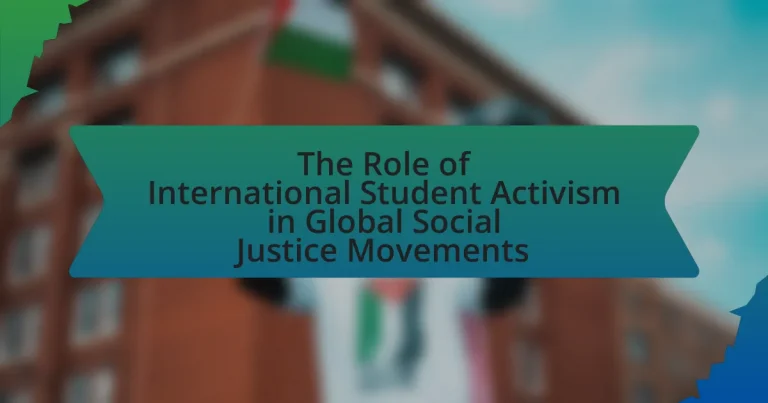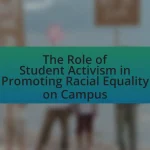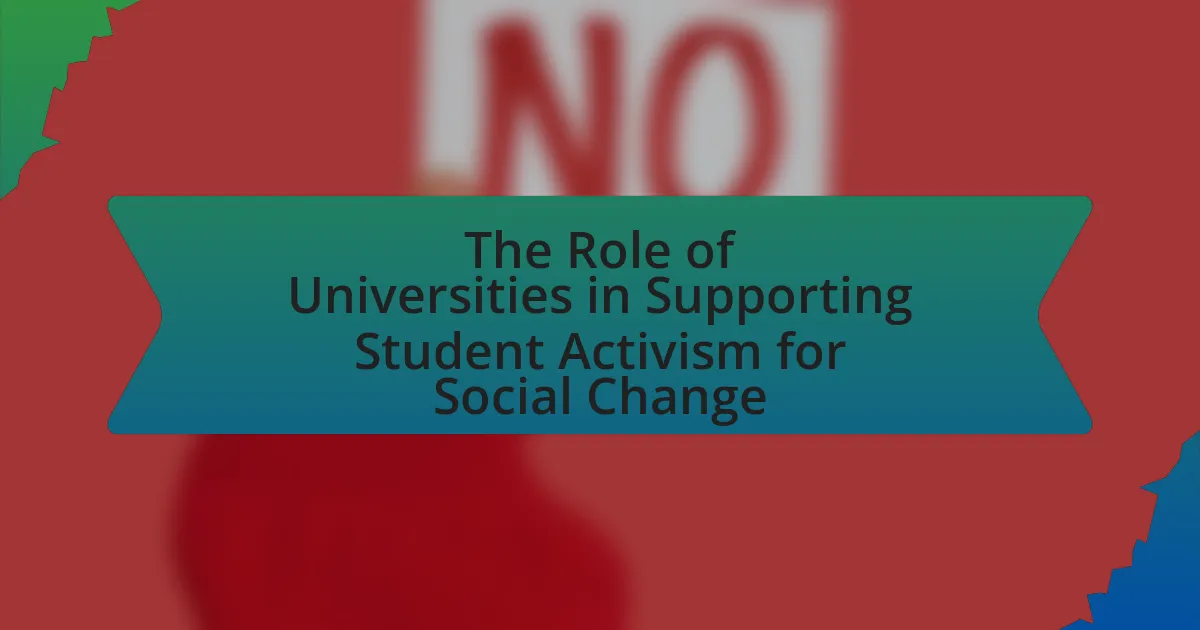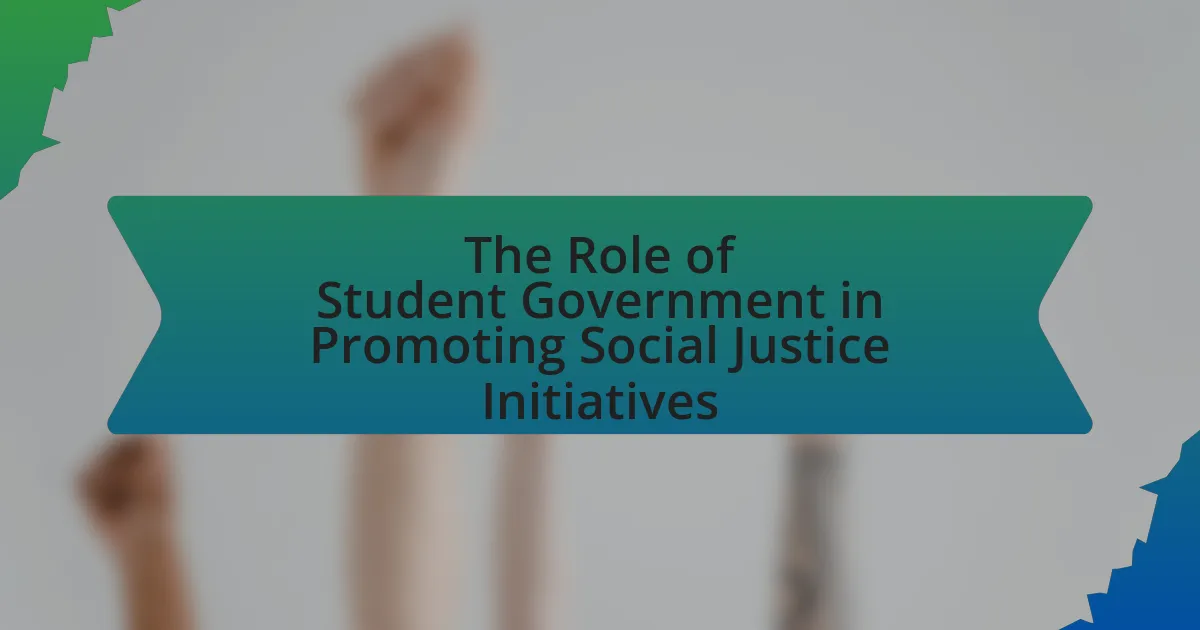International student activism is a vital component of global social justice movements, mobilizing diverse voices to address issues such as inequality, human rights, and environmental justice. The article explores the evolution of this activism, highlighting historical events that have shaped its trajectory and the cultural differences that influence student engagement worldwide. It examines the significance of international student organizations and coalitions in amplifying voices and fostering solidarity, as well as the challenges faced by activists, including legal restrictions and cultural barriers. Additionally, the article discusses the impact of digital platforms on activism strategies and the outcomes of student-led initiatives in influencing policy changes and promoting social justice.
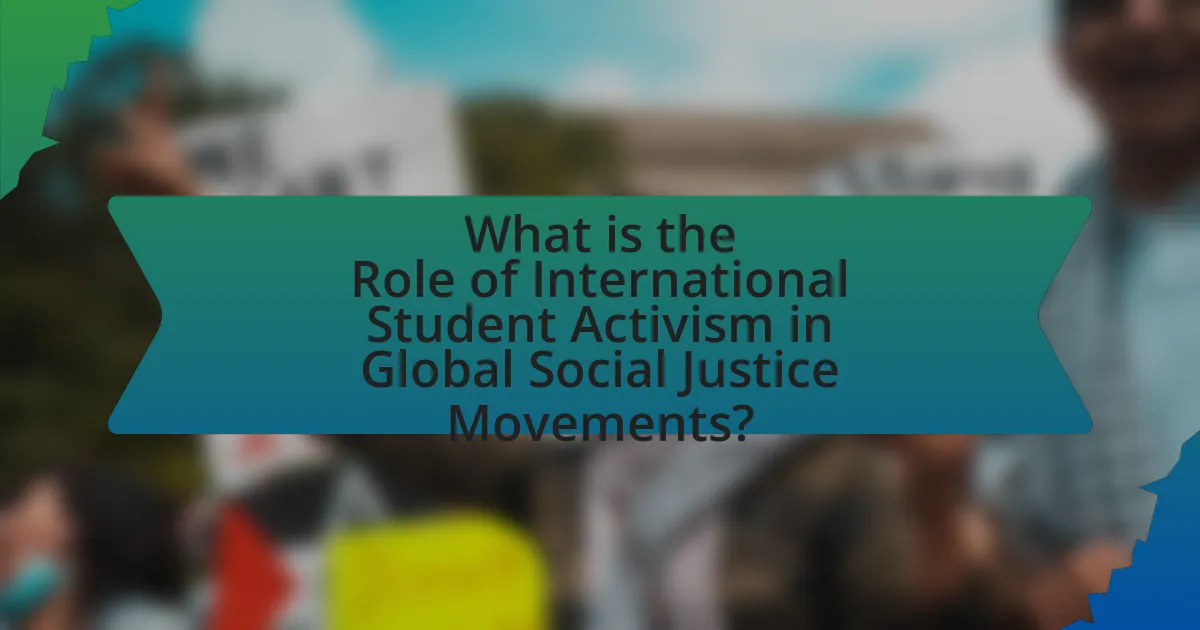
What is the Role of International Student Activism in Global Social Justice Movements?
International student activism plays a crucial role in global social justice movements by mobilizing diverse voices and fostering solidarity across borders. This activism often addresses issues such as inequality, human rights, and environmental justice, leveraging the unique position of students who are often more open to progressive ideas and collective action. For instance, the Global Climate Strike, initiated by students, has united millions worldwide to demand urgent action on climate change, demonstrating the power of student-led initiatives in shaping public discourse and policy. Additionally, international student organizations, such as the International Students for Social Equality, actively engage in campaigns that highlight systemic injustices, thereby amplifying marginalized perspectives and contributing to a more inclusive global dialogue on social justice.
How has international student activism evolved over time?
International student activism has evolved significantly from the early 20th century to the present day, transitioning from localized protests to a global movement addressing diverse social justice issues. Initially, in the 1920s and 1930s, international student organizations focused on anti-war sentiments and promoting peace, exemplified by the establishment of the International Student Union in 1925. By the 1960s, activism expanded to include civil rights, anti-colonial struggles, and educational reforms, as seen in the involvement of students in the civil rights movement in the United States and protests against the Vietnam War.
In the late 20th and early 21st centuries, the rise of digital communication transformed international student activism, enabling rapid mobilization and coordination across borders. Events like the 2011 Arab Spring showcased how students utilized social media to organize protests against oppressive regimes. Furthermore, contemporary issues such as climate change, racial justice, and gender equality have become focal points for international student activism, with movements like Fridays for Future and Black Lives Matter gaining traction among students worldwide. This evolution reflects a shift towards a more interconnected and intersectional approach to social justice, demonstrating the growing influence of international student voices in global movements.
What historical events have shaped international student activism?
Historical events that have shaped international student activism include the May 1968 protests in France, which inspired global student movements advocating for social change, and the anti-apartheid movement in South Africa, where students played a crucial role in opposing racial segregation. The Tiananmen Square protests in 1989 also significantly impacted international student activism, highlighting demands for democracy and human rights. Additionally, the global response to the Vietnam War mobilized students worldwide against militarism and imperialism, fostering a culture of activism that transcended national borders. These events collectively illustrate how international student activism has been influenced by broader socio-political contexts and movements for justice.
How do cultural differences influence student activism globally?
Cultural differences significantly influence student activism globally by shaping the values, priorities, and methods of engagement among students in various regions. For instance, in collectivist cultures, such as those in many Asian countries, student activism often emphasizes community solidarity and group action, leading to organized movements that reflect societal norms and collective goals. In contrast, individualistic cultures, like those in the United States, tend to promote personal expression and individual rights, resulting in activism that focuses on personal freedoms and self-advocacy.
Moreover, cultural contexts dictate the issues that students prioritize. In regions facing political oppression, such as in parts of the Middle East, student activism may center around demands for democratic reforms and human rights, while in Western countries, issues like climate change and social justice may take precedence. Historical events also play a crucial role; for example, the legacy of apartheid in South Africa has fostered a strong tradition of activism among students that continues to influence contemporary movements.
Research indicates that these cultural frameworks not only affect the topics of activism but also the strategies employed. A study by the Institute of International Education highlights that students from different cultural backgrounds utilize varying forms of protest, from peaceful demonstrations to digital activism, reflecting their cultural norms and societal expectations. Thus, cultural differences are fundamental in shaping the landscape of student activism worldwide, influencing both the issues addressed and the methods of engagement.
Why is international student activism important for social justice?
International student activism is crucial for social justice because it amplifies diverse voices and perspectives in global movements. This activism fosters solidarity among students from various cultural backgrounds, enabling them to address issues such as inequality, discrimination, and human rights violations collectively. For instance, the 2019 global climate strikes, led by students including international participants, highlighted the urgent need for climate justice, demonstrating how student activism can influence policy and raise awareness on critical social issues. By mobilizing across borders, international students contribute to a more inclusive dialogue on social justice, ensuring that marginalized voices are heard and considered in the fight for equity and justice worldwide.
What impact does student activism have on local communities?
Student activism significantly impacts local communities by driving social change and raising awareness on critical issues. For instance, student-led initiatives often address local concerns such as environmental sustainability, education reform, and social justice, mobilizing community members to participate in advocacy efforts. Research indicates that student activism can lead to policy changes at local government levels, as seen in the 2018 student-led March for Our Lives movement, which influenced gun control legislation in various states. Additionally, student activism fosters a sense of community engagement and empowerment, encouraging collaboration between students and local organizations to tackle pressing societal challenges.
How does international student activism contribute to global movements?
International student activism significantly contributes to global movements by fostering cross-cultural solidarity and mobilizing collective action on pressing social issues. This activism often transcends national boundaries, as students share experiences and strategies through digital platforms, leading to coordinated efforts such as the Global Climate Strike, which saw millions of students worldwide participating in protests for climate action. Furthermore, international student organizations, like the International Students for Liberty, advocate for policies that promote freedom and social justice, amplifying voices from diverse backgrounds. The impact of such activism is evident in historical contexts, such as the role of student movements in the anti-apartheid struggle in South Africa, where international student solidarity played a crucial role in raising awareness and pressuring governments to act.
What challenges do international student activists face?
International student activists face significant challenges, including legal restrictions, cultural barriers, and limited access to resources. Legal restrictions often manifest as visa limitations that hinder their ability to organize and participate in protests or advocacy efforts. Cultural barriers can lead to misunderstandings or lack of support from local communities, making it difficult for international students to effectively communicate their causes. Additionally, limited access to financial and institutional resources can impede their ability to mobilize and sustain activism, as many rely on external funding or institutional support that may not be readily available. These challenges collectively hinder the effectiveness and reach of international student activism in global social justice movements.
How do political climates affect student activism?
Political climates significantly influence student activism by shaping the environment in which students organize and express their views. In repressive political climates, such as authoritarian regimes, students often face censorship, surveillance, and potential violence, which can stifle activism and lead to underground movements. Conversely, in democratic settings, students typically enjoy greater freedom of speech and assembly, facilitating open protests and advocacy efforts. Historical examples include the Tiananmen Square protests in 1989, where a repressive political climate led to a violent crackdown on student activists, contrasting with the widespread student-led protests during the Arab Spring, which thrived in more open political environments. Thus, the nature of the political climate directly impacts the strategies, visibility, and effectiveness of student activism.
What barriers do international students encounter in their activism?
International students encounter several barriers in their activism, including language barriers, cultural differences, legal restrictions, and lack of institutional support. Language barriers can hinder effective communication and expression of ideas, making it difficult for international students to engage in discussions or mobilize support. Cultural differences may lead to misunderstandings or misinterpretations of activism practices, which can alienate students from local communities. Legal restrictions, such as visa limitations and regulations on protests, can prevent international students from participating fully in activism. Additionally, a lack of institutional support from universities can leave international students feeling isolated and without resources to organize or advocate for their causes. These barriers collectively impede the ability of international students to contribute meaningfully to social justice movements.
How do international student organizations facilitate activism?
International student organizations facilitate activism by providing a platform for students to unite around common causes, share resources, and amplify their voices on global issues. These organizations often host events, workshops, and campaigns that educate members about social justice topics, fostering a sense of community and collective action. For instance, the International Student Organization at the University of California has successfully mobilized students to advocate for climate change policies, demonstrating the effectiveness of organized efforts in influencing institutional decisions. Additionally, these organizations often collaborate with local and international NGOs, enhancing their reach and impact in social justice movements.
What roles do student unions and associations play in activism?
Student unions and associations play a crucial role in activism by organizing collective actions, advocating for student rights, and raising awareness on social justice issues. These organizations mobilize students to participate in protests, campaigns, and discussions that address various societal challenges, such as inequality, climate change, and education reform. For instance, the National Union of Students in the UK has historically led campaigns for affordable education and against tuition fee increases, demonstrating their influence in shaping policy and public opinion. Additionally, student unions often serve as platforms for marginalized voices, fostering inclusivity and solidarity among diverse student populations, which enhances the overall impact of activism in promoting social change.
How do these organizations collaborate with global movements?
Organizations collaborate with global movements by forming alliances, sharing resources, and coordinating campaigns that align with shared social justice goals. For instance, international student organizations often partner with established global movements like the United Nations’ Sustainable Development Goals, leveraging their networks to amplify advocacy efforts. This collaboration is evidenced by events such as the Global Student Forum, where representatives from various countries unite to discuss strategies and share best practices for activism. Additionally, these organizations utilize digital platforms to mobilize support and disseminate information rapidly, enhancing their impact on global issues like climate change and human rights.
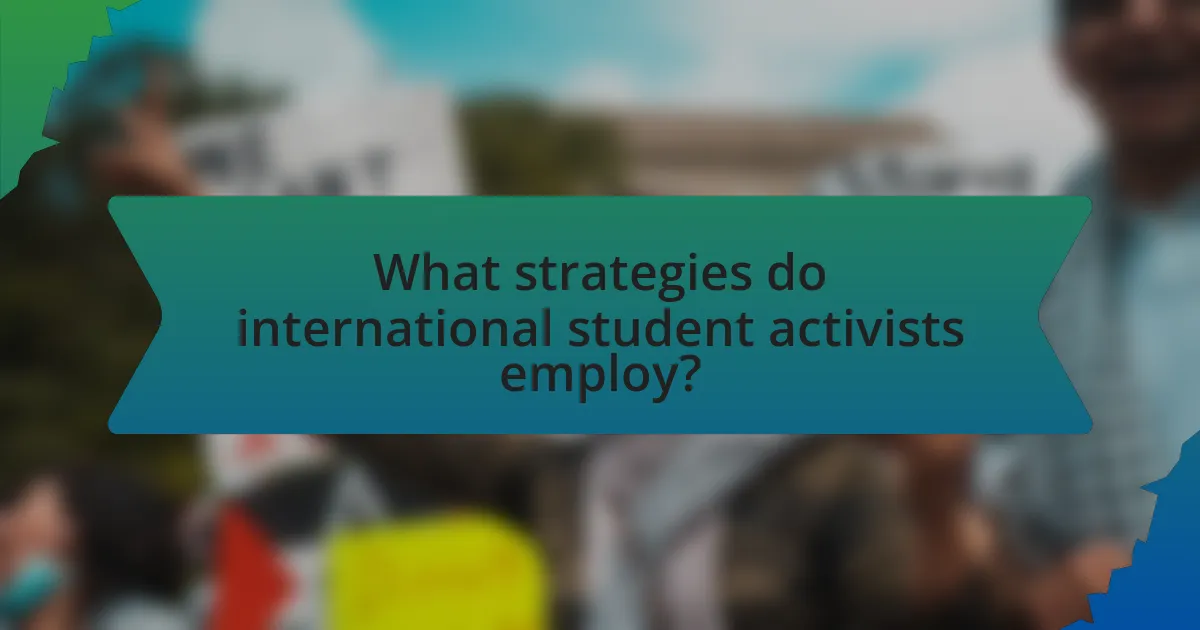
What strategies do international student activists employ?
International student activists employ strategies such as organizing protests, leveraging social media, forming coalitions, and engaging in advocacy to influence policy changes. These strategies enable them to raise awareness about issues affecting their communities, mobilize support, and create a platform for dialogue. For instance, social media campaigns can amplify their messages to a global audience, while coalitions with local organizations can enhance their impact through shared resources and networks. Research indicates that these methods have been effective in various movements, such as the global climate strikes led by youth activists, demonstrating the power of collective action in driving social change.
How do social media and technology enhance activism?
Social media and technology enhance activism by providing platforms for rapid communication, mobilization, and awareness-raising. These tools allow activists to share information instantly, organize events, and reach a global audience, significantly amplifying their message. For instance, the Arab Spring in 2011 demonstrated how social media facilitated coordination among protesters and informed the world about their struggles, leading to widespread support and solidarity. Additionally, studies show that campaigns utilizing social media can increase engagement and participation; for example, a 2018 study published in the Journal of Communication found that social media campaigns led to a 30% increase in participation in social movements. Thus, social media and technology are crucial in enhancing the effectiveness and reach of activism.
What platforms are most effective for international student activism?
Social media platforms such as Facebook, Twitter, and Instagram are the most effective for international student activism. These platforms enable students to connect globally, share information rapidly, and mobilize support for various causes. For instance, Facebook groups have been instrumental in organizing protests and events, while Twitter allows for real-time updates and engagement with broader audiences. According to a study by the Pew Research Center, 69% of adults in the U.S. use Facebook, making it a powerful tool for reaching a large demographic. Additionally, Instagram’s visual storytelling capabilities help convey messages effectively, attracting attention to social justice issues.
How do digital campaigns mobilize support for social justice?
Digital campaigns mobilize support for social justice by leveraging social media platforms and online tools to raise awareness, engage communities, and facilitate collective action. These campaigns utilize targeted messaging and visual content to highlight social justice issues, often reaching a global audience quickly. For instance, the #BlackLivesMatter movement gained significant traction through digital platforms, mobilizing millions to participate in protests and advocacy efforts. Research indicates that social media can amplify marginalized voices, as seen in studies showing that online activism can lead to increased offline participation in social movements.
What forms of protest are commonly used by international student activists?
International student activists commonly use protests, demonstrations, sit-ins, and online campaigns to voice their concerns. These forms of protest allow them to mobilize support, raise awareness, and advocate for issues such as tuition fees, immigration policies, and social justice. For instance, sit-ins have historically been effective in drawing attention to specific grievances, while online campaigns leverage social media to reach a broader audience and facilitate global solidarity.
How do peaceful protests differ from more radical approaches?
Peaceful protests differ from more radical approaches primarily in their methods and objectives. Peaceful protests aim to raise awareness and advocate for change through non-violent means, such as marches, sit-ins, and demonstrations, which have historically been effective in garnering public support and influencing policy, as seen in the Civil Rights Movement led by Martin Luther King Jr. Radical approaches, on the other hand, may involve direct action, civil disobedience, or even violence to achieve their goals, often resulting in immediate disruption and potential backlash from authorities. For example, the Weather Underground Organization in the 1970s employed radical tactics to oppose the Vietnam War, which led to significant controversy and division within the anti-war movement.
What role do art and culture play in student activism?
Art and culture serve as powerful tools in student activism by fostering community engagement and amplifying social messages. Through creative expressions such as music, visual arts, and performance, students can effectively communicate their causes, mobilize support, and inspire action. Historical examples include the use of protest songs during the Civil Rights Movement, which galvanized youth participation and raised awareness about racial injustices. Additionally, cultural events and art installations can create safe spaces for dialogue, allowing students to explore and challenge societal norms. This interplay between art, culture, and activism not only enhances visibility for social issues but also cultivates a sense of identity and solidarity among student activists.
How do international student activists build coalitions?
International student activists build coalitions by leveraging shared experiences and common goals to unite diverse groups. They often organize events, workshops, and campaigns that highlight issues affecting students globally, such as immigration policies, educational access, and social justice. For instance, the Global Student Forum, which connects student organizations worldwide, exemplifies how activists can collaborate across borders to amplify their voices and influence policy changes. Additionally, social media platforms serve as vital tools for communication and mobilization, allowing activists to share resources and strategies effectively. This collaborative approach enhances their capacity to advocate for change and fosters solidarity among international student communities.
What strategies are effective for forming alliances with local groups?
Effective strategies for forming alliances with local groups include establishing mutual goals, engaging in open communication, and demonstrating cultural sensitivity. Establishing mutual goals ensures that both international students and local groups share a common purpose, which fosters collaboration. Engaging in open communication allows for the exchange of ideas and concerns, building trust and understanding between parties. Demonstrating cultural sensitivity involves respecting local customs and practices, which enhances rapport and encourages local groups to participate actively. These strategies are supported by research indicating that successful alliances often hinge on shared objectives and respectful interactions, as seen in various social justice movements where diverse groups unite for common causes.
How do these coalitions amplify their voices in social justice movements?
Coalitions amplify their voices in social justice movements by uniting diverse groups to create a stronger, collective impact. This collaboration allows for the sharing of resources, knowledge, and strategies, which enhances visibility and influence. For instance, the Global Student Forum, which includes various student organizations worldwide, has successfully mobilized thousands of students to advocate for climate justice, demonstrating the power of collective action. Additionally, coalitions can leverage social media platforms to disseminate their messages widely, reaching broader audiences and fostering solidarity across different movements. This strategic alignment not only increases awareness but also pressures policymakers to address social justice issues more effectively.

What are the outcomes of international student activism?
International student activism leads to significant outcomes such as policy changes, increased awareness of social justice issues, and the fostering of global solidarity among diverse student populations. For instance, movements like the 2019 Hong Kong protests saw international students mobilizing to advocate for democratic reforms, which garnered global media attention and influenced international diplomatic discussions. Additionally, international student activism has been instrumental in shaping educational policies, as seen in the advocacy for tuition fee reductions and improved mental health services in various countries. These outcomes demonstrate the power of collective action among international students to effect change and promote social justice on a global scale.
How does international student activism influence policy changes?
International student activism influences policy changes by mobilizing collective action and raising awareness on critical issues affecting students globally. This activism often leads to significant policy shifts, as seen in various instances where student-led movements have successfully advocated for changes in immigration laws, tuition fees, and educational rights. For example, the 2019 global climate strike, which involved students from numerous countries, pressured governments to adopt more aggressive climate policies, demonstrating the power of organized student voices in shaping legislative agendas. Additionally, research by the Institute of International Education highlights that student activism can lead to increased dialogue between policymakers and educational institutions, fostering an environment where student concerns are addressed in policy formulation.
What examples exist of successful policy advocacy by student activists?
Successful policy advocacy by student activists includes the 2018 March for Our Lives movement, which was initiated by students from Marjory Stoneman Douglas High School in response to gun violence. This movement successfully influenced legislation on gun control, leading to the passage of laws in several states aimed at enhancing background checks and restricting access to firearms for individuals deemed a threat. Another example is the climate strikes led by students globally, particularly the Fridays for Future movement initiated by Greta Thunberg, which has pressured governments to commit to more aggressive climate policies, resulting in increased attention to climate change in political agendas worldwide. These instances demonstrate the significant impact student activists can have on shaping public policy and driving social change.
How do these changes impact future generations of students?
Changes in international student activism significantly empower future generations of students by fostering a culture of global awareness and social responsibility. This empowerment leads to increased engagement in social justice issues, as students learn to advocate for their rights and the rights of others through collaborative efforts across borders. For instance, the rise of digital platforms has enabled students to organize and mobilize quickly, as seen in movements like the Global Climate Strike, where students worldwide coordinated actions to demand climate justice. Such activism not only cultivates leadership skills but also instills a sense of solidarity among diverse student populations, preparing them to tackle complex global challenges in the future.
What lessons can be learned from international student activism?
International student activism teaches the importance of solidarity and collective action in advocating for social justice. This activism often transcends national boundaries, demonstrating how students can unite across cultures to address global issues such as climate change, human rights, and educational equity. For instance, the global student protests for climate action, inspired by figures like Greta Thunberg, illustrate how coordinated efforts can amplify voices and influence policy changes worldwide. Additionally, international student movements have historically played a crucial role in challenging oppressive regimes, as seen during the anti-apartheid movement in South Africa, where students were pivotal in mobilizing both local and international support. These examples highlight that international student activism not only fosters a sense of community but also serves as a powerful catalyst for change on a global scale.
How can future activists apply these lessons to their movements?
Future activists can apply lessons from international student activism by fostering global solidarity and leveraging digital platforms for outreach. Historical examples, such as the role of student movements in the anti-apartheid struggle, demonstrate that collective action across borders can amplify voices and create significant change. Additionally, utilizing social media for organizing and mobilizing, as seen in the Arab Spring, allows activists to reach wider audiences and coordinate efforts effectively. These strategies highlight the importance of collaboration and technology in enhancing the impact of social justice movements.
What best practices can enhance the effectiveness of student activism?
Effective student activism can be enhanced through strategic organization, clear communication, and coalition-building. Strategic organization involves creating structured plans that outline goals, timelines, and responsibilities, which increases efficiency and focus. Clear communication ensures that messages resonate with diverse audiences, utilizing social media and traditional platforms to amplify reach. Coalition-building fosters alliances with other groups, enhancing resources and support; for instance, the 2019 climate strikes saw students collaborate globally, resulting in millions participating and significant media coverage. These practices collectively strengthen the impact of student activism in advocating for social justice.
What resources are available for aspiring international student activists?
Aspiring international student activists can access various resources, including organizations, online platforms, and educational materials. Organizations such as the International Student Association and the National Union of Students provide networking opportunities, advocacy training, and support for activism initiatives. Online platforms like Change.org and social media networks facilitate the mobilization of campaigns and awareness-raising efforts. Additionally, educational materials from universities and NGOs, such as guides on effective activism and social justice, equip students with the necessary skills and knowledge to engage in activism effectively. These resources collectively empower international student activists to contribute meaningfully to global social justice movements.
How can students access training and support for activism?
Students can access training and support for activism through various organizations, workshops, and online resources dedicated to social justice. Many universities offer programs that include training sessions on advocacy, organizing, and leadership skills, often facilitated by experienced activists or faculty members. Additionally, organizations such as Amnesty International and the United Nations Association provide resources and training opportunities specifically designed for youth and student activists. Research indicates that participation in structured training programs significantly enhances students’ effectiveness in activism, as evidenced by increased engagement and successful campaign outcomes.
What networks exist for connecting student activists globally?
Several networks exist for connecting student activists globally, including the International Student Movement (ISM), the Global Student Forum (GSF), and the Student Action Network (SAN). The International Student Movement facilitates collaboration among student organizations worldwide, advocating for educational rights and social justice. The Global Student Forum serves as a platform for students to engage in dialogue and share strategies for activism, focusing on issues like climate change and inequality. The Student Action Network connects student activists to share resources and mobilize for various causes, enhancing their collective impact. These networks provide essential support and resources, fostering a united front for student activism on a global scale.
